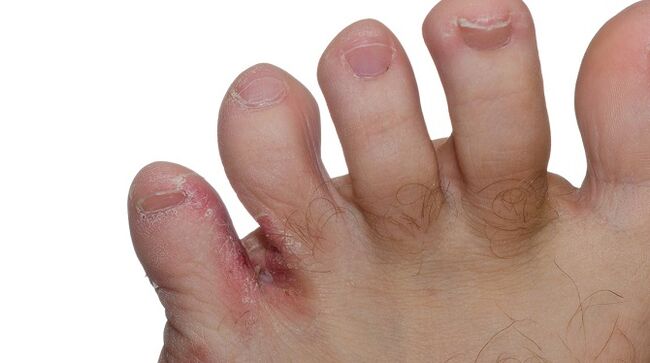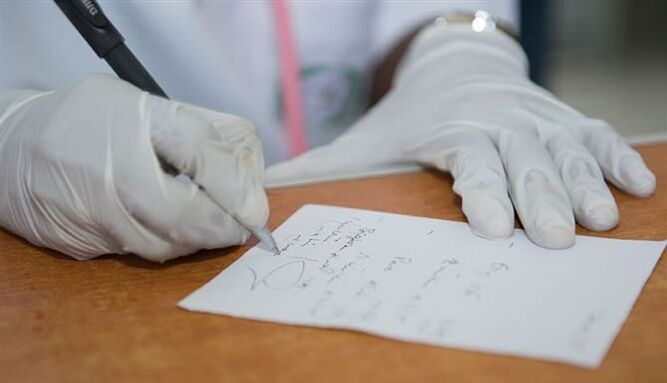What is interdigital fungus on the feet? What does it look like?
- Sudden cracks appear on the feet and toes, most commonly starting from the little toe;
- Loss of skin around the crack;
- Slight itching that disappears after hygiene procedures.

- Clear blisters between the fingers become ulcers and rupture, forming wounds;
- Itching and burning sensation intensify, and severe pain occurs;
- The fungal disease has spread to the nails and begins to destroy them.
Causes of interdigital mycosis
- Going to public places where you walk barefoot or use someone else's shoes, towel or washcloth;
- Shoes that are too tight can cause microtrauma;
- Excessive sweating combined with a careless attitude towards hygiene procedures;
- decrease in immunity;
- Varicose veins;
- hormonal imbalance;
- Dysbiosis.
Fungal infection risk
How to Treat Toe Fungus
pill
- The most commonly prescribed drugs are allylamines. He was able to cure the fungus on his fingers in 3-4 weeks. The maximum daily dose is 250 mg.
- Triazole derivatives are the next broad spectrum drugs. Its intake is limited to two tablets per day. Two two-week courses are required to be completed, with a 21-day break in between.
- Triazole products are available in capsule form and are used to treat a variety of skin conditions. This medicine also helps fight fungus between the toes of the feet. There are 2 options for taking it: 50 mg once a day, or 150 mg once a week but immediately. The course of treatment is 4-6 weeks.
ointment

- Imidazole derivatives are the leader in compassion for those who decide to eliminate foot fungus at home. The reasons are efficiency and reasonable prices. The drug is applied to clean fingers and nails 2-3 times a day. The duration of the treatment course is individual and controlled by the doctor. After symptoms disappear, it is recommended to continue treatment for 2 weeks or longer.
- Products of the imidazole group are used twice a day and the duration of treatment is 4-6 weeks, but in advanced cases the composition needs to be applied for a few more days. Apply a compress with ointment when the fungus spreads to the nail.
- Allylamine creams also fall into the topical product category. The active ingredient is the substance the cream is named after. The ointment is applied 1-2 times a day; if the feet are affected, the application period is up to 4 weeks. If the nail plate has been affected by fungal disease, it is recommended to treat the feet for 3 to 6 months.
bathing place
- coffee.For this process you will need ground coffee: 10 tablespoons. Pour 2 liters of boiling water into the lake. When the "drink" has cooled, put your feet in it. Coffee foot baths can be done twice a day.
- Sagebrush.To prepare, take a liter of boiling water and 150 g of herbs. Water bath for 30 minutes and decoct the soup. The duration of this procedure is at least half an hour.
- Boric acid- A well-known treatment for fungus between the fingers. For bathing, take 40 g of powder and dissolve it in water (50-60 °C). There is no need to overdo this procedure; do it 2-3 times a week.
- salt and soda.Pour warm water into a container and add 1 tbsp. Lake sodium chloride and sodium carbonate. Place your feet in the tub for at least 15 minutes, then rinse with water.
- Celandine.2 tbsp. Pour the herbs into a liter of boiling water, cover and wait to cool to room temperature. The duration of this process should be at least a quarter of an hour.
compression
- Propolis.Use alcohol tincture when applying compresses. Soak the cotton and hold it between your fingers. The procedure lasts a week and a half.
- Birch tar.Before applying this composition, feet are thoroughly steamed and dead skin removed. Dry feet were lubricated with tar, and the spaces between the toes were treated with special care. Keep this compression on for at least an hour and then wipe off the excess tar with a napkin. It is forbidden to wash your feet for two days. The total number of procedures is 4-5 times.
- garlicCrush and mix with salt. Garlic dressing should not be left out for too long. Leave the product on for 1-2 hours.
- ammonia.Take 1 tablespoon per glass of water. Lake then soaks a piece of gauze in the solution and wraps it around the foot. Place a bag on top and a sock on top. Approximately 8-10 procedures need to be performed.
- onionJust as effective as garlic. Only use juice in this case. Leave the compress on overnight. If the skin between your fingers becomes moist and you experience a strong burning sensation, mix juice and petroleum jelly in equal parts.
physiotherapy
- Ozone therapy.This procedure can significantly accelerate the growth of healthy nails when the disease is severely advanced. During this process, the plates and skin are filled with ozone and oxygen, which stimulates nail growth while destroying fungal infections. Not only fungus on the skin of the toes, but absolutely all types of fungal diseases were successfully treated.
- Laser Treatment.During this operation, only cells colonized by the fungus are destroyed. The course of treatment includes 4-10 surgeries. No preliminary preparation is required, but concurrent drug treatment is required.
diet
- alcoholic beverages;
- Candy, flour products;
- sugary fermented dairy products;
- candy;
- sausage;
- canned food;
- bacon;
- Meat;
- Semi-finished product.
- Cereals (except semolina and rice only);
- coffee;
- sugar-free dairy and cultured dairy products;
- seafood;
- vegetables, vegetables;
- nuts, seeds;
- boiled fish;
- butter and vegetable oil;
- Tea;
- Egg.
How to prevent disease recurrence
- Wear shoes that fit your feet to avoid injuring your toes. It is better to give priority to natural materials. Frequent disinfection of shoes is necessary.
- Precautions need to be taken with feet after being in public places: wash and lubricate them with lemon juice, paying special attention to your toes.
- Changing socks every day is a must. It is best to choose cotton products.
- Exchanging shoes and linens, or using someone else's towels and pedicure supplies is prohibited.
- Strengthening your immune system is a priority, so your diet should always include fruits, juices, and vegetables.















